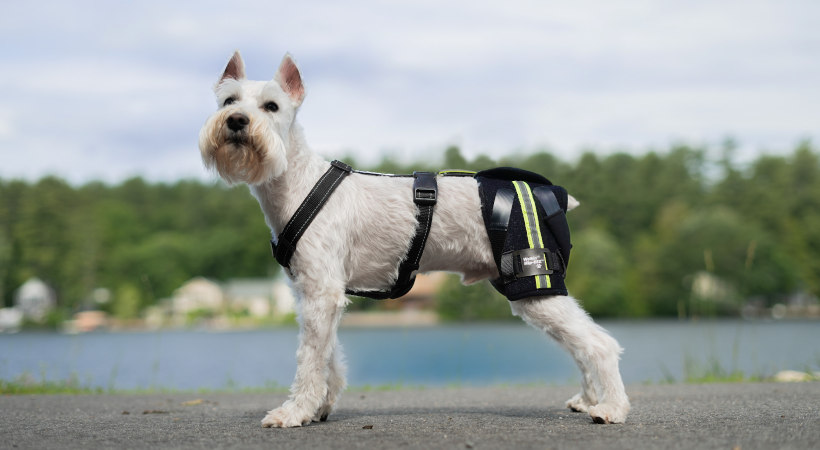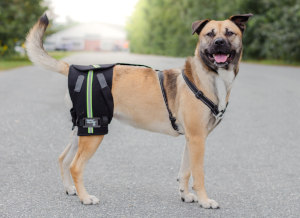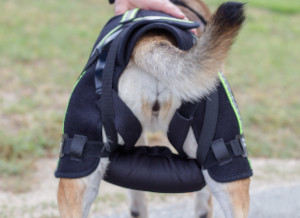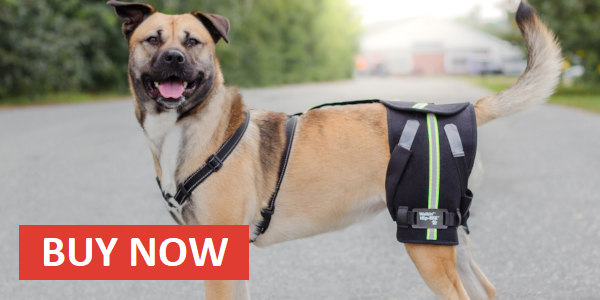Hind Leg Crossing
The crossing of your dog’s back legs is one of the early symptoms of neurological deficits in its hind end. Leg weakness can cause muscles to atrophy and weaken the muscles in the rear end. As a dog’s back legs progressively lose strength and control, the hind legs start to cross uncontrollably. This can be one of the early symptoms of Degenerative Myelopathy (DM).
What is Degenerative Myelopathy?
Degenerative Myelopathy (DM) is a progressive spinal disease that generally occurs in dogs between 8 and 11 years old. This painless disease is very similar to Lou Gehrig’s disease or ALS in humans. DM begins with hind leg crossing and slight hind quarter weakness and progresses to complete paralysis.
Hind leg crossing is one of the earliest signs that a dog’s back legs are weakening. Although Degenerative Myelopathy is incurable, regular exercise with a rehab practitioner can slow the disease’s progression.
Treating Hind Leg Crossing in Dogs
Uncontrollable hind leg crossing needs to be treated immediately. If you start to notice your dog’s hind legs crossing or becoming weakened, it is important to talk to your Vet right away. Your Vet will begin the process of ruling out a diagnosis until they can determine the underlying cause.
Hip-EEZ Cross Assist

The Hip-EEZ provides hip joint support and can be worn during canine physical therapy. To treat hind leg crossing and train your dog’s muscles NOT to cross, the Hip-EEZ can be combined with the Cross-Assist attachment. This hip brace training tool is perfect for pets with hind leg weakness and crossing due to injury or disease.
The Cross-Assist attachment secures to the Walkin’ Hip-EEZ support system and sits up high between your dog’s legs to train the leg muscles to hold proper hip alignment and proper gait.
Most dogs whose back legs cross when they walk are losing hind leg strength. So they need a rehab tool that won’t weigh them down or make it more difficult for the dog to walk. The Cross-Assist attachment is lightweight and made of foam that is able to be adjusted to the correct width to fit between the legs of all dog sizes and will move with your pup as they walk!
Hydrotherapy
Hydrotherapy is an excellent way to strengthen your dog’s hind leg muscles without putting stress on their joints! The water allows the dog to become buoyant, so they don’t have to support their full body weight. Additionally, the water offers some resistance when the dog walks, which will help them to rebuild strength and minimize muscle loss.
The hydro therapist will work with your dog, focusing on how they move and place their paws to improve their gait and strengthen their muscles. An underwater treadmill is the most common method of hydrotherapy for dogs working on gait correction, although a swimming pool may also be utilized.
Proactive Solutions
Awareness of how your dog moves are crucial to catching degenerative illnesses early! Therapies like the Hip-EEZ Support System, Hydrotherapy, and most physical therapies are always more effective in slowing the disease’s progression the earlier you start!




MY 11 year old DOG, ABOUT 110 POUNDS, has had what appears to have had Degenerative Myelopathy development since she was 1 yr old. She is on her feet just to go potty, ans I walk her most days about a half block. Some days she refuses to walk. She is overweight due to inactivity. I give her about 1.5 cups of dry dog food and a few duck or chicken jerky treats. Now her front, left shoulder is causing her to liimp I think.
I give her a few Cosequin and Hip & Joint chews daily.
Years ago I read that there was nothing I could do to help her hip Degenerative Myelopathy issues. After seeing thisAD, I wonder if it isn’t too late to help her.